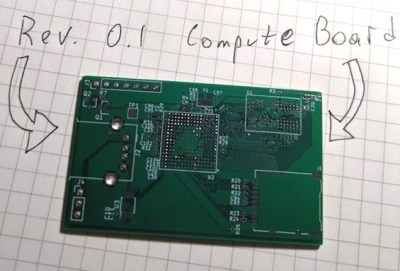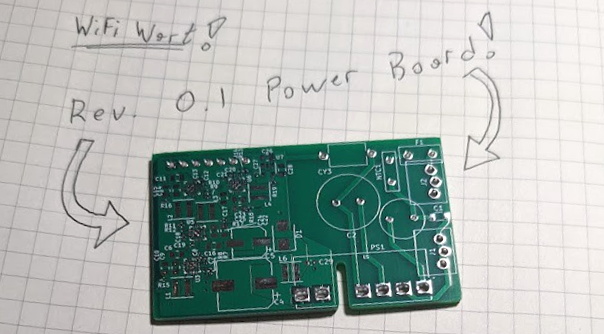We’ve been eagerly following the development of the WiFiWart for some time now, as a quad-core Cortex-A7 USB phone charger with dual WiFi interfaces that runs OpenWrt sounds exactly like the sort of thing we need in our lives. Unfortunately, we’ve just heard from [Walker] that progress on the project has been slowed down indefinitely by crippling chip shortages.
At this point, we’ve all heard how the chip shortage is impacting the big players out there. It makes sense that automakers are feeling the pressure, since they are buying literally millions of components at a clip. But stories like this are a reminder that even an individual’s hobby project can be sidelined by parts that are suddenly 40 times as expensive as they were when you first put them in your bill of materials.

In this particular case, [Walker] explains that a power management chip you could get on DigiKey for $1.20 USD a few months ago is now in such short supply that the best offer he’s found so far is $49.70 a pop from an electronics broker in Shenzhen. It sounds like he’s going to bite the bullet and buy the four of them (ouch) that he needs to build a working prototype, but obviously it’s a no go for production.
Luckily, it’s not all bad news. [Walker] has made some good progress on the power supply board, which will eventually join the diminutive computer inside the USB charger enclosure. Part of the trick is that the device is still supposed to be a functional USB charger, so in addition to 5 VDC for the output port, the power supply also needs to produce 1.1 V, 1.35 V, 2.5 V, 3.0 V, and 3.3 V for the computer. We’re glad to see he’s taking the high road with his mains circuitry, making sure to use UL listed components and maintaining proper isolation.
When we last checked in on the WiFiWart back in July, [Walker] had already managed to boot Linux on his over-sized prototype board. Now he’s got PCBs in hand that look far closer to the final size and shape necessary to tuck them into a phone charger. It’s a shame that the parts shortage is slowing down progress, but we’re confident we’ll at least get to see a one-off version of the WiFiWart powered up before the year is out.
















Change the design to use what Onion Mega uses. MT7688AN which is MIPS24KEc. It runs WRT. The onion is so small it could go in to a 12w wall adapter. You could even stick a camera on it in that size.
I got bit by the IC shortage in the same way: I designed a board with a chip in stock everywhere and then a week later, the entire global supply of LM5164 chips (by TI) evaporated except some warehouses in China which ran an insane markup. I’m only making a few boards, so I just redesigned for a different (less capable) PMIC but it was a pain and limits which battery packs I can use. >:(
I think there’s an LM5164 here: https://www.flywing-tech.com/search/LM5164
Recently, there were about a dozen ICM20649s available for general purchase in the US, and five of them were sitting on my workbench. It was an oddly powerful feeling.
Better wait with detailed design until you have all parts in your hands. Distributors no longer stock large quantities, there are just too many parts and variants. This problem isn’t new, I had to change several designs in the last two decades due to suddenly unavailable (and often trivial) parts.
The thing is, this is the 3rd rev of his board, so the design was already detailed an parts bought before the chip he needed went out of stock.
That said, he probably should have bought more qty of his ICs initially. He’s planning on doing a kickstarter eventually anyways, why not get a light qty discount in the first place?
CH552G which have USB and programmable IO/I2C/etc… with Arduino IDE with a 8051 are out of stock as well:
https://www.lcsc.com/product-detail/Microcontroller-Units-MCUs-MPUs-SOCs_WCH-Jiangsu-Qin-Heng-CH552G_C111292.html
Have you looked at 552C? C is virtually identical to G except it does not need external oscillator. Normally it’s a little more expensive than G at pre-pandemic price.
So whoever can get in contact with Walker, his best options are to buy some PBO-3C-5 (only 600mA) if he can manage or to use a different voltage module and add a switching regulator. It’s frustrating but the parts that go out of stock now will take at least a year to come back in stock. It’s best to adapt than wait.
Personally putting WiFi in charge of a phone charger seems like a recipe for disaster. How long after [ or before ] it’s release, will someone find a way to force it to overcharge a phone and cause a fire. Guess time will tell.
pull not push buddy!
You do realize that there’s at least two layers of protection from that happening with modern phones, one is a dedicated protection circuit mounted right on the battery and the second is every phone has a charge controller that’ll regulate charging the battery. So it’s not up to the wallwart to force overcharging since it was never in control of charging the battery directly in the first place. Now if you are naughty you could potentially abuse qc3 to send a higher voltage than a particular phone can survive.
I don’t think you understand what this project is. It’s a Linux computer hiding inside a normal looking phone charger for penetration testing purposes.
The charging aspect is just so it doesn’t make anyone suspicious. The Linux side has no control over it.
Just an innocent wall wart here, nothing special to see here! Yup, yup, I’ll charge your phone for you, that’s what *I* do! Yup! Charge, charge, charge-ity charge .. say, maybe your BOSS would like to use me to charge HIS phone?
Given the possibly of millions of electronic parts that combine to make up our group hobbyists part bins, do we have a place where People can go to source hard to find items? Usually when I buy for projects I have always bought extras that I never use – I have chips from the early 80’s and newer, including things like the newest regulators and such.
It’s possible that the community would like to setup a place to barter for these items People might need to complete their projects if they can be found. Is there a board for that? Or is that just too much work? In the past it wouldn’t be necessary, but now maybe an evolution of the community is needed
https://www.tindie.com/browse/flea-market/
Given the shortages it’d be great if Hackaday ran an article rallying everyone to scrape together all their spares and throw them up on tindie. I’m sure I’ve got a couple reels of power regulators lying around somewhere from a project I did a few years ago, if only I could find them…
Thx
I changed to SW only with the HW shortages. Go cloud.
I was looking at this project to do, but pretty much any IC in the partlist and alternatives had something like a year lead time. I’ll wait it out, i have enough crap going on anyway.
Back when I designed my first PCB, I learned that just because a part is available when you make the design doesn’t mean you’ll be able to order them once your first PCB’s arrived.
Now, even if it slows things down (doesn’t matter for a hobbyist like me) I always order all my parts before I finalize and order the PCB’s.
Also gives some good perspective on simplifying designs, “do I really need this many different resistors and capacitors”, “this component’s a bit small, maybe I shouldn’t use so many per board” etc.
Also means you’re designing from a stockpile, so I tend to prefer the components I have left over from the last project to whatever may be slightly more suited for the new one.
Not a word about counterfeits? The “chip shortage” is a boon for counterfeiters. And, Shenzhen is almost synonymous with counterfeits. Good luck with foreign “brokers” that are the only source for otherwise unavailable chips – or anything else!